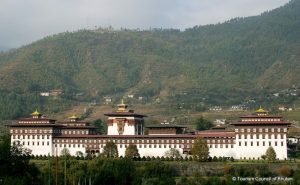Thimphu, the capital of Bhutan, is a city with a population of over 100,000 people located in western central Bhutan.
Not only is the city well-known for its rich culture and numerous Buddhist sites, but it also offers a breathtaking Himalayan landscape. Visitors can explore blue alpine forests, peaceful lakes, and admire cave murals at ancient temples, or buy traditional garments at the Weekend Handicrafts Market. Moreover, Thimphu is famous for its architecture and historic sites, including Tashichho Dzong, the city’s largest monastery, National Memorial Chorten, and the gold-plated Buddha Dordenma statue.
Tashichhodzong Fortess
Tashichho Dzong is a Buddhist Monastery and fortress on the northern edge of the city of Thimphu in Bhutan, on the western bank of the Wang Chu.
 It has traditionally been the seat of the Druk Desi (or “Deb Raja”), the head of Bhutan’s civil government, an office which has been combined with the kingship since the creation of the monarchy in 1907, and the summer capital of the country. In old British documents, it is known as Tassisudon.
It has traditionally been the seat of the Druk Desi (or “Deb Raja”), the head of Bhutan’s civil government, an office which has been combined with the kingship since the creation of the monarchy in 1907, and the summer capital of the country. In old British documents, it is known as Tassisudon.
It was built by the first Dharma Raja, who also founded the Lho-Drukpa sect of Buddhism, which has remained the distinctive sect of Bhutan. The correct transliteration of the vernacular name—Bkrashis-chhos-rdzong, meaning “the fortress of auspicious doctrine”—is, according to Graham Sandberg, Tashichhoidzong.
Folk Heritage Museum
Welcome to the Folk Heritage Museum located in Kawajangsa, in the heart of the capital city, Thimphu.
The Folk Heritage Museum is within walking distance of the National Library of Bhutan and the National Institute for Zorig Chusum (13 Traditional Arts). The Folk Heritage Museum dedicates itself to connecting people with the rich Bhutanese Folk heritage and rural history through exhibits, demonstrations, educational programs, and documentation of Bhutanese rural life. The Museum will strive to disseminate the rich cultural heritage across generations by preserving it in different forms. Read More
Simply Bhutan Museum
The interactive ‘living’ museum Simply Bhutan gives visitors a quick introduction to various aspects of traditional life in Bhutan.
The museum guides visitors through mocked-up village scenes while offering a shot of local arra (rice spirit) to greet them. Visitors can also dress up in traditional clothes, try out archery, and hear songs sung by Bhutanese women while they build houses out of rammed earth. It’s a touristy place, but it provides a good family experience. The museum also has souvenir stalls and a restaurant that serves Bhutanese set meals for Nu 700.
Largest Buddha Statue
Bhutan’s capital city of Thimphu is home to a colossal golden Buddha statue atop a hill.
The statue is not just one Buddha, but 125,000 miniature Buddhas encapsulated inside the bronze chest of the enlightened statue. The 169-foot-tall statue, which cost nearly $100 million to build, was constructed in 2015 to honor the fourth king of Bhutan on his 60th birthday. The miniature Buddhas inside the statue range from 8 to 12 inches tall, and they are also gilded and made of bronze. Therefore, Thimphu has more Buddhas than human beings, which is quite remarkable, given that the city’s population is around 100,000.
The Prophecy: The statue also fulfills two prophecies. The first is that a Buddhist statue would be built in the region to bring blessings, peace, and happiness to the world, as foreseen by yogi Sonam Sangpo. Additionally, Guru Padmasambhava, known as the “second Buddha,” mentioned the statue in the eighth century, making it a significant spiritual site for many Buddhists. This statue fulfills both prophecies in a stunning manner, shining like a beacon of peace, happiness, and spiritual enlightenment atop the hill in Thimphu.

